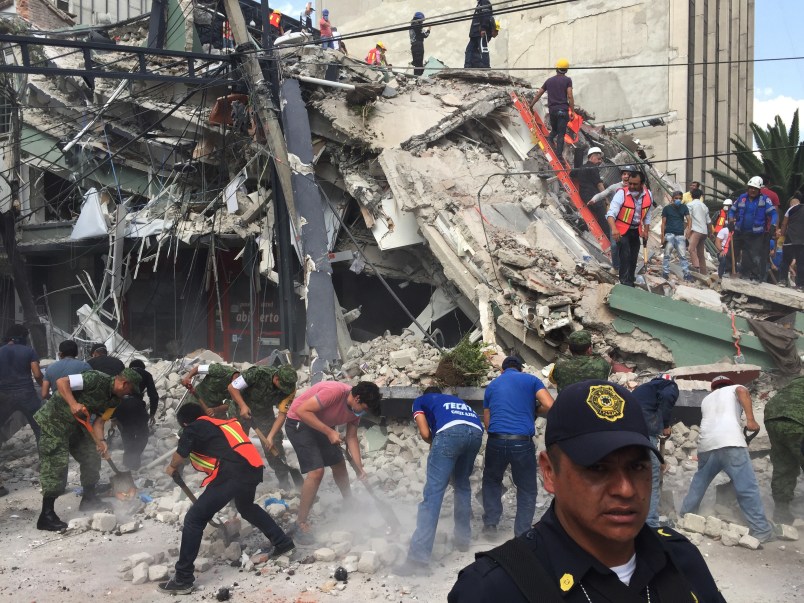MEXICO CITY (AP) — A magnitude 7.1 earthquake rocked central Mexico on Tuesday, killing at least 61 people as buildings collapsed in plumes of dust. Thousands fled into the streets in panic, and many stayed to help rescue those trapped.
The quake came less than two weeks after another quake left 90 dead in the country’s south, and it occurred as Mexicans commemorated the anniversary of a 1985 quake that killed thousands.
Dozens of buildings collapsed into mounds of rubble or were severely damaged in in densely populated parts of Mexico City and nearby states. A column of smoke rose from a structure in one central neighborhood in the capital.
Morelos Gov. Graco Ramirez reported on Twitter that at least 42 people had died in his state south of Mexico City.
At least 11 others died in Puebla state, according to Francisco Sanchez, spokesman for the state’s Interior Department.
Gov. Alfredo del Mazo said at least eight had died in the State of Mexico, which also borders the capital.
There were no immediate official reports of deaths in the capital, but journalists witnessed some people who had apparently died.
Rescue workers rushed to the site of damaged or collapsed buildings in the capital, and reporters saw onlookers cheer as a woman was pulled from the rubble.
Rescuers immediately called for silence so that they could listen for others who might be trapped.
Mariana Morales, a 26-year-old nutritionist, 26, was one many who spontaneously participated in rescue efforts.
She wore a paper face mask and her hands were still dusty from having joined a rescue brigade to clear rubble from a building that fell in a cloud of dust before her eyes, about 15 minutes after the quake.
Morales said she was in a taxi when the quake struck, and she out and sat on a sidewalk to try to recover from the scare. Then, just a few yards away, the three-story building collapsed.
Gala Dluzhynska was taking a class with 11 other women on the second floor of a building on the trendy Alvaro Obregon street when the quake struck and window and ceiling panels fell as the building began to tear apart.
She said she fell in the stairs and people began to walk over her, before someone finally pulled her up.
“There were no stairs anymore. There were rocks,” she said.
They reached the bottom only to find it barred. A security guard finally came and unlocked it.
The quake caused buildings to sway sickeningly in Mexico City and sent people throughout the city fleeing from homes and offices, and many people remained in the streets for hours, fearful of returning to the structures.
Alarms blared and traffic stopped around the Angel of Independence monument on the iconic Reforma Avenue.
Electricity and cellphone service was interrupted in many areas and traffic was snarled as signal lights went dark.
The U.S. Geological Survey said the magnitude 7.1 hit at 1:14 p.m. (2:15 p.m. EDT) and it was centered near the Puebla state town of Raboso, about 76 miles (123 kilometers) southeast of Mexico City.
Puebla Gov. Tony Gali tweeted that there had been damaged buildings in the city of Cholula including collapsed church steeples.
Earlier in the day workplaces across the city held readiness drills on the anniversary of the 1985 quake, a magnitude 8.0 shake, which killed thousands of people and devastated large parts of Mexico City.
In that tragedy, too, ordinary citizens played a crucial role in rescue efforts that overwhelmed officials.
Market stall vendor Edith Lopez, 25, said she was in a taxi a few blocks away when the quake struck. She said she saw glass bursting out of the windows of some buildings. She was anxiously trying to locate her children, whom she had left in the care of her disabled mother.
Local media broadcast video of whitecap waves churning the city’s normally placid canals of Xochimilco as boats bobbed up and down.
Mexico City’s international airport suspended operations and was checking facilities for any damage.
Much of Mexico City is built on former lakebed, and the soil can amplify the effects of earthquakes centered hundreds of miles away.
The new quake appears to be unrelated to the magnitude 8.1 temblor that hit Sept. 7 off Mexico’s southern coast and which also was felt strongly in the capital.
U.S. Geological Survey seismologist Paul Earle noted that the epicenters of the two quakes are 400 miles (650 kilometers) apart and most aftershocks are within 100 kilometers.
There have been 19 earthquakes of magnitude 6.5 or larger within 250 kilometers of Tuesday’s quake in the past century, Earle said.
Earth usually has about 15 to 20 earthquakes this size or larger each year, Earle said.
Initial calculations show that more than 30 million people would have felt moderate shaking from Tuesday’s quake. The US Geological Survey predicts “significant casualty and damage are likely and the disaster is potentially widespread.”







Are we going to help the Mexicans or is Trump still pissed that they won’t pay for his miserable wall? Helping is what neighbors do you know.
Watching a live report on my local Univision tv station right now. Wow what a confused mess it seems like.They had a scroll of 195 dead.